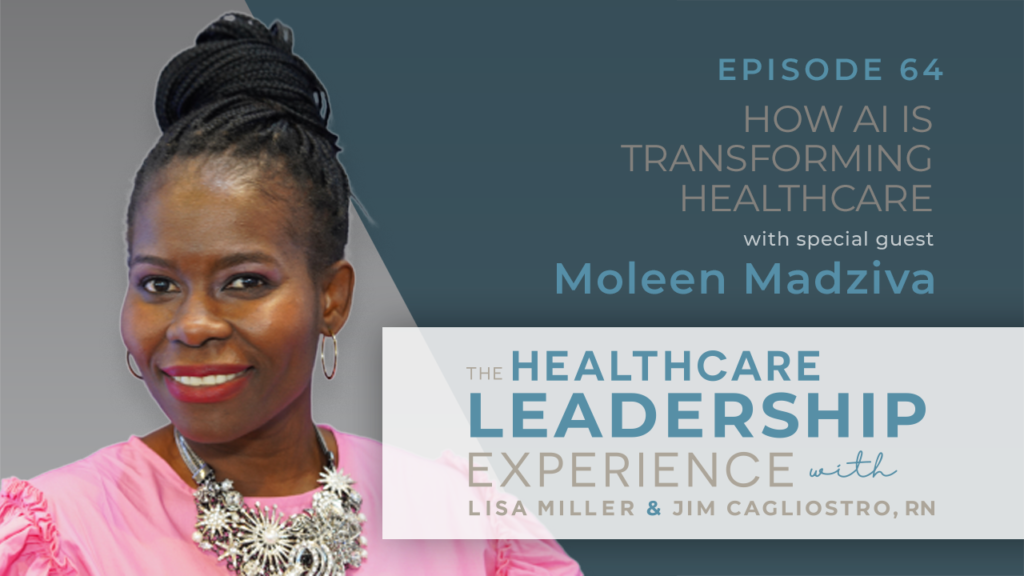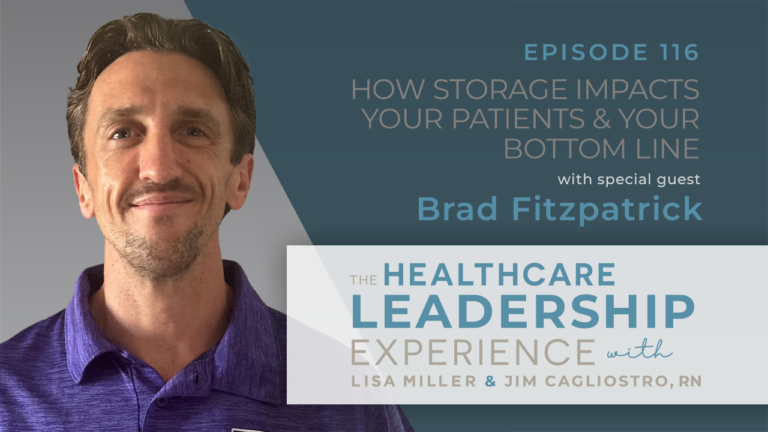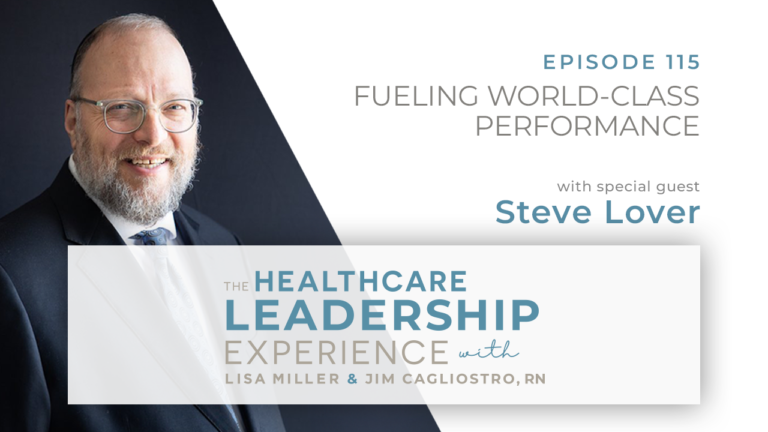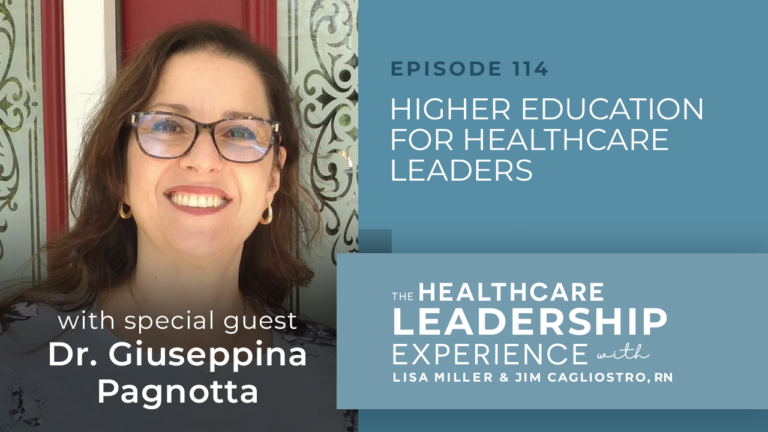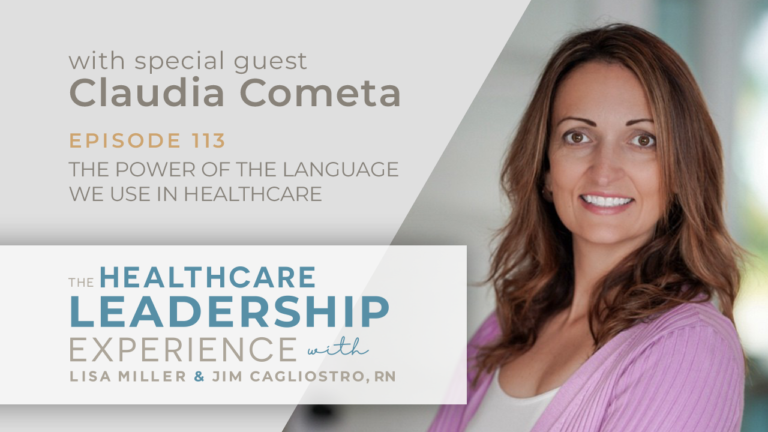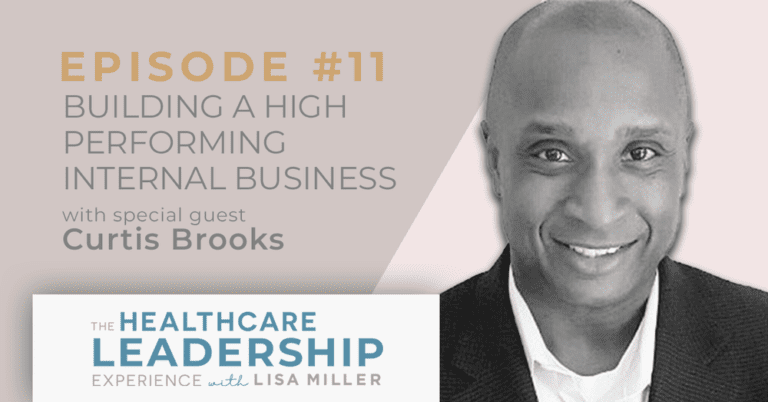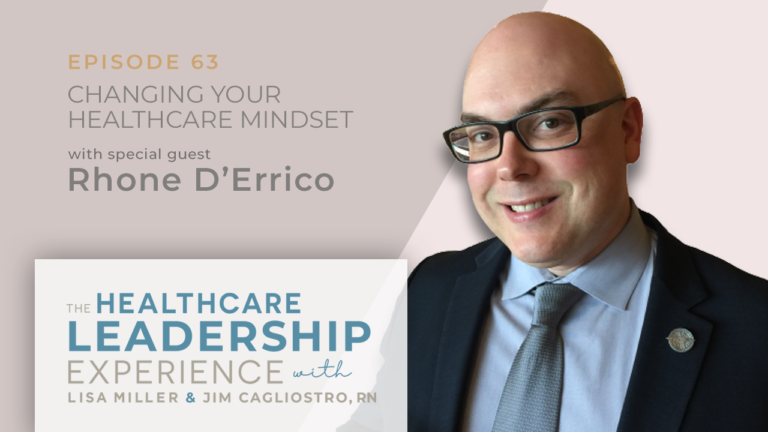Episode Introduction
As AI continues to reshape healthcare, Moleen explains how Viz’s cloud based system drives efficiencies in patient care, and reveals the unique mobile app with a critical impact on surgeon decision making. She also explains why hospitals must allow the data to lead, how Viz.ai systems work in parallel with clinical workflow and why ‘’kindness wins’ permeates the company’s approach to building relationships.
Show Topics
- How our lived experiences shape healthcare leadership
- Detecting disease on a medical image with AI
- Enhancing patient care with a mobile app
- Allowing the data to lead
- The importance of human connection
- Inspiring change with personal integrity
- Getting everyone on the same page
05:04 How our lived experiences shape healthcare leadership
Moleen recalled how her community upbringing taught her the real meaning of wealth and empowered her for her role at Viz.ai.
‘’I was born and raised in Zimbabwe in Southern Africa, so shout out to all my fellow Zimbabweans out there. We are really flying the Zimbabwe flag high. I’m based out here in the US and currently living in Southern California. I was raised in a small village called Macheke and I really lived under communitarian community that really honored what it meant to have each other’s back. It wasn’t until much later as I was growing up that I realized how wealthy and how rich I was because my upbringing was really filled with so much love and care and really nourishing me with culture that has really been shaping generations for so many centuries, but in such a way that even now as someone in technology and clinical research, I realize that all of those lessons have really empowered me for the type of leader that I am, but also for how I visualize doing ethical clinical science.’’
07:56 Detecting disease on a medical image with AI
Moleen explained how Viz.ai’s cloud based system drives care efficiencies.
‘’So our mission at Viz is to bring lifesaving treatments to patients. …So think of it this way, when a patient comes into the ER for example, they get a medical image like a CT scan. That image actually is shipped to the Viz system that sits in the cloud, and from there it is processed and almost pretty much in real time the care coordination team, the physicians and everyone else in that system is able to get the notification for them to be able to start deciding what to do for the patient. One of the things that we’re talking about when we say we drive efficiency in care is that we are bringing all the key stakeholders for that care coordination in one place, in a HIPAA-compliant platform where everyone can communicate and be able to really drive efficiency in how patients are cared for. So that’s one piece.’’
10:18 Enhancing patient care with a mobile app
Moleen explained how the Viz app enables surgeons to make critical decisions from anywhere in the world.
‘’So we have a mobile app also it’s available through the web where the rest of the team that’s actually put onto to the Viz system are able to see within their clinical hospital system what they need to be doing for the patients that they get the notifications for. So in many ways it’s really more about bringing key stakeholders into one place so that they can actually be able to efficiently make decisions. Think of it this way, let’s just say that a very key surgeon is not on campus at the time and they’re away somewhere, but a critical case that is come through. Instead of waiting for the surgeon to drive all the way back to the hospital and make some decisions, after looking at a case on a computer on campus, they can actually make that decision from wherever they are in the world, 24/7 by actually being able to access the Viz app on their mobile application.’’
12:59 Allowing the data to lead
Moleen said that allowing the data to lead can help to overcome hesitancy around AI in healthcare.
‘’When we think about hesitancy, a lot of times it’s really more about not having really led more from understanding how do you validate it? How do they see the economic impact? How are they actually able to make decisions really from allowing the data to lead. This is where I really come in in my role recognizing that yes, we have an amazing marketing team, we have a great engineering team and AI team, but research is really integral to what we do because then we’re able to really validate for real world evidence that can support a lot of the decision makers who may have had questions. So any of the research questions that we ask really should be really lending more to where is the gap within the clinical discourse? Where is some of the hesitancy? How can we actually start making some of those decisions a little bit easier for those that are tied to making these very important decisions for any of their healthcare systems across the country?’’
14:45 The importance of human connection
Moleen explained that Viz.ai systems work in parallel with clinical workflow.
‘’So as I pre-empted earlier in my introduction of myself really having been born and raised in a communitarian spirit and recognizing that human touch is really the integral part of who we are as a human experience, but what I can say is at Viz.ai, we really developed our AI systems that work in parallel with the clinical workflow. So we’re not replacing radiologists or any other of the specialists. What we’re actually doing is just providing a tool that can actually make their work more efficient. So there are several different areas that we work with experts within the field to really be able to drive that point that we are not here to as a replacement, we actually honor the fact that there is a human touch.’’
17:49 Inspiring change with personal integrity
Moleen emphasized the need for starting with the ‘’why’’ to get buy-in on strategy and change.
‘’… for me it always starts with my own personal values that then overlay onto my professional brand in the work that I’m actually set to do at Viz. From a personal perspective it is really more about integrity. In who I am I am actually able to define what sort of work I want to do in the world and how I do that work. But most importantly why. So we always want to start with the why because as we’re inspired, others then really begin to buy into the story because they’re recognizing this is actually legacy work. It is beyond what we are doing in our time. What I really wish to see is 50 years from now, a hundred years from now, well past our time, others will remember and look back and say, we’re so grateful that there was this generation that came in and did such quality work with such kindness, with such quality in such a way that they really opened up the door for what AI can do, what clinical trials and clinical research can actually do in terms of shaping the direction in which healthcare is going.’’
20:30 Getting everyone on the same page
Moleen said looking for things people have in common helps to overcome differences.
‘’So as part of my self development, my professional development, I recently took a course out of University of Pennsylvania through the MBA program that’s called Executive Presence and Influence. One of the things we’re talking about in that class is really recognizing that influence is a lot more about narrative. So really beginning more with my story so that we can actually find ways in which we have a lot more in common than we have in differences, but also really being able to have this specific communication that recognizes that you may not be seeing things from my vantage point because you are not there yet. So I tend to be very patient. When I’m building relationships with our clinical partners I recognize that it is really more about waiting until the time is right for us to move a certain project in a different direction. In the meantime we continue to build the relationship through other things where they’re kind of ready to actually be able to talk about.’’
Show Links
Connect with Lisa Miller on LinkedIn
Connect with Jim Cagliostro on LinkedIn
Connect with Moleen Madziva on LinkedIn
Check out VIE Healthcare and SpendMend
You’ll also hear:
Moleen’s career history, from engineering graduate at Drexel University, to Viz.ai, via telecommunications and clinical trials. ‘’When I joined about two years ago we didn’t have a structured clinical program, so it has really been my task every single day to ensure that we can bring forward a clinical science program, clinical operations program, and expand it.’’
The growing impact of Viz.ai in global healthcare. ‘’We are live in about 1400 hospitals across the US and also live now in the number of hospitals within the European region. So just to be able to say that, yes, there are many hospitals that are recognizing the impact of AI and really leaning into embracing what it can actually do within their systems.’’
‘’Kindness wins’’: How Viz.ai’s core value permeates their approach to customers, physician partners and clinical partners.
Putting patients first: inspiring change based on the premise that ‘’no patient should get left behind.’’
Bringing lifesaving treatment more efficiently to patients. Why Viz.ai’s mission is a legacy work. ‘’We’re not doing it just for one company or one patient. We’re really doing that as a global phenomenon.’’
What To Do Next:
- Subscribe to The Economics of Healthcare and receive a special report on 15 Effective Cost Savings Strategies.
- There are three ways to work with VIE Healthcare:
- Benchmark a vendor contract – either an existing contract or a new agreement.
- We can support your team with their cost savings initiatives to add resources and expertise. We set a bold cost savings goal and work together to achieve it.
- VIE can perform a cost savings opportunity assessment. We dig deep into all of your spend and uncover unique areas of cost savings.
If you are interested in learning more, the quickest way to get your questions answered is to speak with Lisa Miller at lmiller@spendmend.com or directly at 732-319-5700
Episode Transcript
CLICK HERE TO DOWNLOAD THE PDF TRANSCRIPT
CLICK HERE TO OPEN THE FULL TRANSCRIPT
Moleen (00:00):
Let’s just say that a very key surgeon is not on campus at the time and they’re away somewhere, but for a critical case that has come through instead of waiting for the surgeon to drive all the way back to the hospital and make some decisions, after looking at a case on a computer on campus, they can actually make that decision from wherever they are in the world, 24/7, by actually being able to access the Viz’s app on their mobile application.
Introduction (00:28):
Welcome to the Healthcare Leadership Experience Podcast, hosted by Lisa Miller and Jim Cagliostro. Lisa is the founder of VIE Healthcare Consulting and now managing director at SpendMend.
Lisa and her team has generated over $1 billion in financial improvements for VIE’s clients since 1999.
Since 2007, Jim has been a registered nurse working in critical care, perioperative services, and outpatient settings at nationally recognized medical facilities across three states. You’ll hear conversations on relevant and trending topics in healthcare and much more. Now, here’s your hosts, Lisa and Jim.
Jim (01:07):
Hi, this is Jim Cagliostro and you’re listening to the Healthcare Leadership Experience. Today’s guest is Moleen Madziva, the healthcare leader with over 12 years of functional R&D and clinical research experience in the medical devices’ industry. She is a senior director of the global clinical affairs at Viz.ai, whose mission is to fundamentally improve how healthcare is delivered through intelligent software.
I’m personally excited to learn more about how artificial intelligence is transforming healthcare today. So welcome Moleen, and I should start out by saying your friends call you Molly. I know we’ve been talking and so I will refer to you as Molly from here on out, but I know on LinkedIn and other places you are Moleen Madziva. Thank you for joining us.
With every guest I like to kind of hear a background and just really know where you’re coming from because I think that’s so important in the world of healthcare. So please tell us a little bit — a few minutes — about your experience, work experience, life experience, education that has brought you and really prepared you for your current role with Viz.ai.
Moleen (02:13):
Absolutely. Thank you, Jim. I count you as one of my newest friends and I’m really honored to be here today. So, I guess just going back in my background, I am a trained engineer and I have been working, since graduating from Drexel University, really in the R&D space and from there working in telecommunications, actually moved to Angel Medical Systems, which is a small medical device company that was tasked with inventing a medical device that warns patients before they have a myocardia infection. I actually then move from the R&D space to supporting preclinical trials and then I moved into the clinical trial space. That’s when I actually caught the bug from being deep in the lab working on software and developing systems, but actually being able to start realizing how all of that remarkable work actually impacts patients every single day.
Moleen (03:09):
I then moved from Angel Medical Systems to join Abbot, much larger company, and I joined the neuromodulation business unit really transitioning from cardiology to neuro where we were working on movement disorder, implantable medical devices into the brain and spine. That work really taught me a ton about clinical research, clinical affairs, regulatory affairs, understanding what is impactful when it comes to recognizing how much goes into getting device through to the FDA, but also beyond that, doing meaningful post-market research.
From there I actually joined Viz and I’m really excited to be here leading the clinical program here where I am the senior director, as you mentioned, of our global clinical program. When I joined about two years ago, we didn’t have a structured clinical program, so it has really been my task every single day to ensure that we can bring forward a clinical science program, clinical operations program, and expand it.
Moleen (04:17):
Now we are actually having sites in Europe that are working with us and having a very courageous approach to how do we marry everything that I know in clinical operations and research with all of the software engineering expertise that I’ve learned from all the way back, if I can go back to Drexel University. I remember some of my professors and some of my advisors really telling me that I’ll go places simply because I really charted the path for joining clinical engineering in a meaningful sense.
I will go a little bit further back before my career, if that’s okay, Jim, because I think this is so impactful because our lived experience really shaped who we also become as we get into leadership roles.
Moleen (05:04):
I was born and raised in Zimbabwe in Southern Africa, so shout out to all my fellow Zimbabweans out there. We are really flying the Zimbabwe flag high. I’m based out here in the US and currently living in Southern California. I was raised in a small village called Macheke and I really lived under communitarian community that really honored what it meant to have each other’s back. It wasn’t until much later as I was growing up that I realized how wealthy and how rich I was because my upbringing was really filled with so much love and care and really nourishing me with culture that has really been shaping generations for so many centuries —but in such a way that even now as someone in technology and clinical research, I realize that all of those lessons have really empowered me for the type of leader that I am, but also for how I visualize doing ethical clinical science.
Jim (06:07):
I love that. I was actually listening to something earlier today and the person was talking about how all of us bring our history and bring our culture with us, and you have so much to bring to the table that the person next to you doesn’t have or might not have or they’re coming from a different perspective, but our lived experience has such an impact and I didn’t realize the background with the engineering specifically, so I’m glad you shared that. Thank you.
So, thinking specifically about Viz.ai, I was doing some research, looking on their website, they have a stated goal of using artificial intelligence to make healthcare work faster and smarter. Something I think we’re all a fan of, we want to see that. What specific problems in healthcare does Viz.ai address — and that might be a loaded question, but I don’t know if you can share a little bit about some specific problems, maybe some examples and how AI can help?
Moleen (06:58):
Yeah, I love that. Thank you so much. And what an honor for me to be the voice of our company at this stage and really being able to bring this to light. One of the things that I’ll say is artificial intelligence is machine learning software that can actually detect disease on a medical image. So you think about a patient who comes in with some symptoms perhaps, they get a medical image, that image goes to Viz system that sits in the cloud, it gets processed, and then the physicians and the team that’s actually here coordinating that patient will get real-time notification of what has been found and what an honor for me to be able to represent Viz and speak about this mission-critical work that we have.
So our mission at Viz is to bring lifesaving treatments to patients. One of the things that we do with the artificial intelligence software is that this machine learning software is able to actually detect disease on a medical image.
Moleen (07:56):
So think of it this way, when a patient comes into the ER for example, they get a medical image like a CT scan. That image actually is shipped to the Viz system that sits in the cloud, and from there it is processed and almost pretty much in real time the care coordination team, the physicians and everyone else in that system is able to get the notification for them to be able to start deciding what to do for the patient.
One of the things that we’re talking about when we say we drive efficiency in care is that we are bringing all the key stakeholders for that care coordination in one place, in a HIPAA-compliant platform where everyone can communicate and be able to really drive efficiency in how patients are cared for. So that’s one piece.
Jim (08:43):
You mentioned that driving efficiency and care, and I know I’ve talked to you a little bit about what we do at VIE Healthcare and SpendMend, but it’s so much about efficiency now. We hate to see waste, we want to bring value, and with AI — I know we’re getting into it and we’re going to hear a little more — there’s such a strong potential for that efficiency to really be exponentially increased. You mentioned care coordination and it is, it’s a huge issue in healthcare, life altering errors, delays, I mean you know this, and I know our listeners know it. Life altering errors and delays are often a direct result of poor care coordination or communication, transfer of care. How can AI help specifically with that care coordination piece of healthcare?
Moleen (09:27):
Yeah, I love that. So one of the things that I say to people all the time is Viz has a fantastic team of engineers that have really done a really great job of developing this system that really work well. They are actually validated and FDA clears them. What I do in my role, which is really exciting, is that I actually then take those same systems and bring them into the real world and we test them out by validating them not only by saying how efficient or how is the performance of the AI algorithm itself, but we also start looking into how is it utilized within the clinical workflow? How are folks communicating with each other so that if it is an acute event that everyone is working very quickly. If it is not an acute event, then the follow-up that need to occur with the patient are also coordinated through that.
Moleen (10:18):
So we have a mobile app also it’s available through the web where the rest of the team that’s actually put onto to the Viz system are able to see within their clinical hospital system what they need to be doing for the patients that they get the notifications for. So in many ways it’s really more about bringing key stakeholders into one place so that they can actually be able to efficiently make decisions. Think of it this way, let’s just say that a very key surgeon is not on campus at the time and they’re away somewhere, but a critical case that is come through. Instead of waiting for the surgeon to drive all the way back to the hospital and make some decisions, after looking at a case on a computer on campus, they can actually make that decision from wherever they are in the world, 24/7, by actually being able to access the Viz app on their mobile application.
Jim (11:14):
That’s incredible and we know that technology is there and it’s been there, but it’s a matter of making it work, bringing it all together. I love hearing that. It’s there. That’s wonderful.
If you’re just tuning in, you are listening to the Healthcare Leadership Experience and I’m your host, Jim Cagliostro. This show is sponsored by VIE Healthcare Consulting, a SpendMend company, which provides leading edge financial and operational consulting for hospitals, healthcare institutions, and other providers of patient care.
Since 1999, VIE has been a recognized leader in healthcare costs, hospital purchase services, healthcare benchmarking, supply chain management, and performance improvement.
You can learn more about VIE Healthcare consulting at viehealthcare.com. Okay, Molly, so in your opinion, are enough organizations embracing the use of AI in healthcare? I don’t know if you want to share examples of that and then why might there be a hesitancy, and I have a few ideas in my mind, but why would some organizations be hesitant to embrace the use of AI in healthcare?
Moleen (12:19):
Great questions as well. So one of the things that I can just say is what’s actually currently happening with Viz. We are live in about 1400 hospitals across the US and also live now in the number of hospitals within the European region. So just to be able to say that, yes, there are many hospitals that are recognizing the impact of AI and really leaning into embracing what it can actually do within their systems. When we think about hesitancy, a lot of times it’s really more about not having really led more from understanding how do you validate it? How do they see the economic impact?
Moleen (12:59):
How are they actually able to make decisions really from allowing the data to lead. This is where I really come in in my role recognizing that yes, we have an amazing marketing team, we have a great engineering team and AI team, but research is really integral to what we do because then we’re able to really validate for real-world evidence that can support a lot of the decision makers who may have had questions. So any of the research questions that we ask really should be really lending more to where is the gap within the clinical discourse? Where is some of the hesitancy? How can we actually start making some of those decisions a little bit easier for those that are tied to making these very important decisions for any of their healthcare systems across the country.
Jim (13:44):
Hmm. You said the magic words that we love here, allowing the data to lead. I think that that’s so important in healthcare and when you’re in healthcare, you’re working with people who are largely scientists in the sense of we want that evidence as a nurse, the evidence-based practice, we want the data to lead, and clearly you’re doing that and it’s exciting and you want it to be accurate and you want to make sure it works, but we have to allow the data to lead. That’s great.
Jim (14:10):
What would you say to those concerned that leaning to heavily on AI might lead us to a healthcare approach that minimizes the power of the human connection? Again, as a nurse, my mind goes to that human connection, and I know that’s important. I know people have mentioned questions about, I mean recently reading the news the last few days, the accuracy of AI. Can we trust it? So maybe those two items, if you want to touch on that. Can we trust it, but also are we at risk of losing that human connection if we rely too heavily on it. How do we balance that?
Moleen (14:45):
Yeah, I love that, Jim, and you had me at human connection. So as I pre-empted earlier in my introduction of myself really having been born and raised in a communitarian spirit and recognizing that human touch is really the integral part of who we are as a human experience, but what I can say is at Viz.ai, we really developed our AI systems that work in parallel with the clinical workflow. So we’re not replacing radiologists or any other of the specialists. What we’re actually doing is just providing a tool that can actually make their work more efficient. So there are several different areas that we work with experts within the field to really be able to drive that point that we are not here to as a replacement, we actually honor the fact that there is a human touch.
Moleen (15:38):
One of the things, I don’t know if you had looked at our website from our corporate core values, we have patient-first really as we are constantly thinking about, while our AI is not necessarily like an implantable device, you can think of this as we care so much about the impact that this AI will have on patients. That’s one thing.
Another thing is we also are looking into the quality of the work we are doing. We are also looking into setting a very broad approach by saying one of our core values is kindness wins. We recognize that we are going to be challenged to be kind to one another as employees advance, but also kind to all of our customers, physician partners, clinical partners that we work with, recognizing that in what we do, we continue to propel and advance and cultivate this culture of kindness and this is what’s going to be so important and integral to that human connection.
Jim (16:36):
So I did see that on the website. I didn’t spend too much time on that, but it stands out to me that here’s an artificial intelligence company, a tech company, which many people would look at, obviously a healthcare company, but right away you think, oh, the tech and it’s patient-first. How do we impact patients? Kindness wins. That’s what again, as a nurse my ears at the bedside, I love to hear that because healthcare ultimately does come to the patients. Why did we get into what we do? It’s because of patients. We want to see people healed. We want to see people get better, walk out the doors. I love that. Thank you, Molly.
Moleen (17:09):
100%.
Jim (17:10):
I think I want to end with this, and this kind of gets off a little bit from the specific work that Viz.ai does, but I saw on your LinkedIn page, and I know even just hearing in this conversation — in terms of culture and what you do, the importance of, you mentioned key stakeholders. How do you most effectively… I saw this on your profile for LinkedIn. How do you win buy-in on strategy and inspire change? I think you also said something about cultivating good teamwork. So this is essential in healthcare, the teamwork, getting buy-in on strategy and inspiring change. Any advice even from just a leadership perspective, how do you do that? How can some of our listeners implement that in their own work?
Moleen (17:49):
Yeah, yeah, absolutely. So for me it always starts with my own personal values that then overlay onto my professional brand in the work that I’m actually set to do at Viz.
From a personal perspective it is really more about integrity. In who I am I am actually able to define what sort of work I want to do in the world and how I do that work —but most importantly why. So we always want to start with the why because as we’re inspired, others then really begin to buy into the story because they’re recognizing this is actually legacy work. It is beyond what we are doing in our time.
What I really wish to see is 50 years from now, a hundred years from now, well past our time, others will remember and look back and say, we’re so grateful that there was this generation that came in and did such quality work with such kindness, with such quality in such a way that they really opened up the door for what AI can do, what clinical trials and clinical research can actually do in terms of shaping the direction in which healthcare is going.
Moleen (18:56):
I really always think about putting patients first, but also thinking about access to care, diversity, and health equity. In what ways can we actually start really inspiring and cultivating the culture of recognizing that we are in this together? No patient should get left behind and it’s very difficult not to get buy-in when you’re starting from their perspective. Everything else will follow, the intellect, the engineering perspective, the great product that we build at Viz. But really we want to start with what is the meta of the human experience?
Jim (19:31):
I remember working in a surgery center and a doctor’s having a bad day, whatever happened in the OR, you just don’t know. And there’s just, there’s a lot of tension. It’s high tension and then there’s a lot of friction and there’s pushback, and we have to remember we’re on the same team. And so that was something that I remember having a conversation with this surgeon and saying, “Hey, like I’m here. How can I support you?” But you also need to recognize when there’s time you got to give space.
I guess as a follow-up, say you do face a team member, or you are having trouble with someone who’s not buying into the strategy, who really is having a hard time lining up with the values — how do you best approach that? And there could be various successful ways of approaching it, but personally, how do you come alongside that person and really say, “Hey, we’re not on the same page. Let’s get on the same page.”
Moleen (20:20):
Yeah, I love that. So I recently actually took a course, I’m a lifelong leaner. One of the things you learn about me is I’m constantly figuring out where else can I grow? How else can I develop?
Jim (20:30)
Sure.
Moleen (20:30):
So a part of my self development, my professional development, I recently took a course out of University of Pennsylvania through the MBA program that’s called Executive Presence and Influence. One of the things we’re talking about in that class is really recognizing that influence is a lot more about narrative. So really beginning more with my story so that we can actually find ways in which we have a lot more in common than we have in differences, but also really being able to have this specific communication that recognizes that you may not be seeing things from my vantage point because you are not there yet. So I tend to be very patient. When I’m building relationships with our clinical partners, I recognize that it is really more about waiting until the time is right for us to move a certain project in a different direction. In the meantime we continue to build the relationship through other things where they’re kind of ready to actually be able to talk about.
Moleen (21:28):
Some of it may be maybe we meet up at a conference where we’re really talking about things that are happening within the industry, some of the common things that we actually are should already be talking about together that really show us that yes, we are facing the same direction. We actually all care about the same mission overall, really about putting patients first. But when I think about my own colleagues at Viz, one of the things that I consider myself is I’m a leader of leaders. Everyone on my team, I really encourage them and bring out the leadership out of them. I really encourage them to realize they’re really seen, they’re heard, they are visible, and that really allows everyone to rise in their own capacity, at their own time to what their potential really is meant to be. And one of another thing that we also work on at Viz is yes, we are actually really working on several portfolios within the area of neuro and vascular and cardiac, but we realize that we are truly one Viz that’s facing the same direction in everything we do.
Moleen (22:34):
We want to ensure that any work that we do should be really leading to our mission, which is really being able to speak more to bringing lifesaving treatment more efficiently to patients. How can that happen through the use of our AI product and also in who we are as a team, showing how we are kind to one another, coming to our customers and our clinical partners and showing them kindness and empathy and working with them at the level that they are ready to work with us because we recognize that this is really a community work. This is a legacy work. We’re not doing it just for one company or one patient. We’re really doing this as truly like a global phenomenon. We’re in a moment that we have been met to challenge ourselves to do the best we can with what we know and what we have.
Jim (23:26):
When I think of Viz.ai, when I’m looking on the website, I think of like you mentioned earlier, marrying the clinical operations and research with the software engineering. And you think of even with the greatest advancements in technology we still bring it back to mission. We bring it back to leadership. You really touched on culture there and creating a space where you can work together as an effective team. I think that’s just wonderful things to keep in mind. No matter how far we get advanced in healthcare, there are still some core values that we need to stick to. Thank you so much, Molly.
Thank you, thank you for being on the show today.
Jim (24:02):
Thank you to our listeners who spent time with us today. If you have any questions about VIE Healthcare Consulting, a SpendMend company, or if you want to reach out to me or Lisa Miller, you can find us on LinkedIn. Again, you can also find Molly on LinkedIn, Moleen Madziva on LinkedIn.
We at VIE love helping hospitals save money and enhance the patient experience, and we are hoping that today’s episode gave you some new insight or ideas to consider and implement to use in your career and your own healthcare organization. So once again, Molly, thank you for your time. Thank you for being with us today.
Moleen (24:36):
Thank you so much, Jim. What an honor.
Speaker (24:38):
Thanks for listening to the Healthcare Leadership Experience podcast. We hope you’ve enjoyed this episode. If you’re interested in learning new strategies, best practices and ideas to utilize in your career and healthcare organization, check out our website at thehealthcareleadershipexperience.com.
And oh yeah, don’t forget to rate and review us and be sure to join Lisa and Jim next time on the Healthcare Leadership Experience podcast. Thanks again for listening.
